Amazon Product Research: Methods to Discover Winning Products

Did you know that selling on Amazon comes with a potential failure rate of 80%-90%? However, the 10% that do end up making it, make it big! Like they really kill it. One of the core reasons why they make it is their ability to conduct effective Amazon product research.
They fundamentally understand that only decisions backed by data result in success.
After all, in the ever-evolving world of e-commerce business, consumer preferences can change in the blink of an eye and successful sellers have no choice by to adapt by staying ahead of the curve.
Use various methods to dive deep into the needs and desires of your target audience, understand their pain points, identify gaps in your competitors’ products, and ultimately, zero in on lucrative opportunities that can propel your business to new heights.
While it can be tempting, simply finding a product you like, creating a listing, and hoping for the best can be ineffective in the long run.
Therefore, we’ve put together this comprehensive Amazon product research guide with effective tips to streamline your Amazon product analysis and research journey.
Let’s jump into it!
Here is a quick peek into the article:
- What is Amazon Product Research?
- Four Elements Influencing Your Product Research on Amazon
- Ways to Discover Good Product Ideas
- Final Thoughts
What is Amazon Product Research?
Amazon product research refers to finding a “winning product” that could turn a hefty profit when sold on Amazon. Unfortunately, you cannot rely solely on gut feelings or passion when it comes to selling a product on Amazon.
For example, you could spend several hundred hours of time and resources coming up with a proprietary product that you think is amazing.
However, if there’s no market demand for it, then your product simply won’t sell on Amazon. Additionally, highly competitive products result in saturated niches that can be extremely hard to break into.
To effectively zero in on a profitable product, you’ll need to deploy a range of strategies to gather data, and thoroughly analyze and validate its potential for success.
Specifically, you need to consider various metrics such as BSR, estimated daily orders, estimated daily revenue, category and subcategory information, and much more. Of course, manual methods of product research may not result in gathering the same level of information as Amazon product analysis with a specialized third-party research tool.
By understanding this data, not only could you find opportunities in a non-competitive niche or the subcategory of a saturated niche. For instance, breaking into the water bottle niche can be challenging. However, there may be potential in the sports water bottle subcategory.
Four Factors That Influence Product Research on Amazon
To effectively validate a product and find lucrative opportunities, you need to consider the following factors:
- Demand
- Customer
- Competition
- Profitability
Demand
Understanding the demand for the product is extremely important. As mentioned earlier, you could potentially lose a significant amount of money trying to sell a product without any demand or by trying to break into a category with high competition.
Therefore, without understanding the demand, you won’t be able to gauge the success of your product.
Here are some key factors that can help you identify demand for a product:
A minimum of 10 estimated daily orders
Find a product that has a higher average unit sales per day. As a baseline, we recommend you keep it to a minimum of 10 estimated orders per day.
This essentially implies that the product that you are trying to sell should have already been sold by at least one other person and should generate a minimum of 10 sales per day. This would also suggest that the product has a good demand with at least 300 orders a month on average.
Of course, there’s the question of profitability as well. Let’s assume that two products are selling at $30. Product A has an average daily order of 5 and product B has an average daily order of 10.
Now, let’s assume that both products have a profit of $10 after the Amazon FBA fees, shipping, Amazon seller promotions, etc. Essentially, the gross sale you make per month in Product A is $30* 5 units * 30 days = $4,500, and in Product B is $30* 10 units * 30 days = $9,000
The profit you make for Product A is = $10 * 5 units/ day * 30 days/ month = $1,500 per month, and Product B is $10 * 10 units/ day * 30 days/ month = $3,000 per month.
As obvious as this may sound, products with higher average sales units per day have better profits. Therefore, aim to sell a product that can at least bring in 9000-10000 in gross sales and at least 3,000 in profit.
A BSR of 5,000 or less in the category
Understanding the sales frequency of a product can be complicated without the right tool. However, you can find the best seller rank (BSR) for free on the ecommerce platform. Most importantly, the BSR can help you understand the sales performance of a product within its category.
Fundamentally, a lower BSR suggests higher sales. For instance, a product with a BSR of 20,000 has significantly fewer daily sales than the same product with a BSR of 2,000 in the same category.
Therefore, avoid selecting a product with low sales potential even if it has found its way to the top pages.
When zeroing in on a product, it’s advisable to have 3-5 products in the main category with a BSR rank of around or below 5,000. The more number of products you have with a low BSR, the better your chances of success.
Note: When examining the BSR, focus on the main category rather than subcategories. Keep in mind a product with BSR #100 in the Electronics category wouldn’t necessarily generate similar sales as a product with BSR #100 in the Pet Supplies category.
We recommend you use SellerApp’s Product Intelligence Tool to find products that can sell on Amazon. Specifically, use SellerApp’s unique “Opportunity Score” feature, which analyzes the product and gives a score based on the following criteria.
- Demand: It calculates the demand for the product in the category
- Revenue Potential: It estimates the monthly revenue of the product in the category
- Competition: It shows if the competition is higher or lower than the category average
- Overhead Cost: It estimates the overhead cost and shows if it’s higher or lower than the category average.
- Profit Margin: It shows you the estimated profit margin of the product compared to the category average
- PIS Index: This metric measures the scope of improvement in the product.
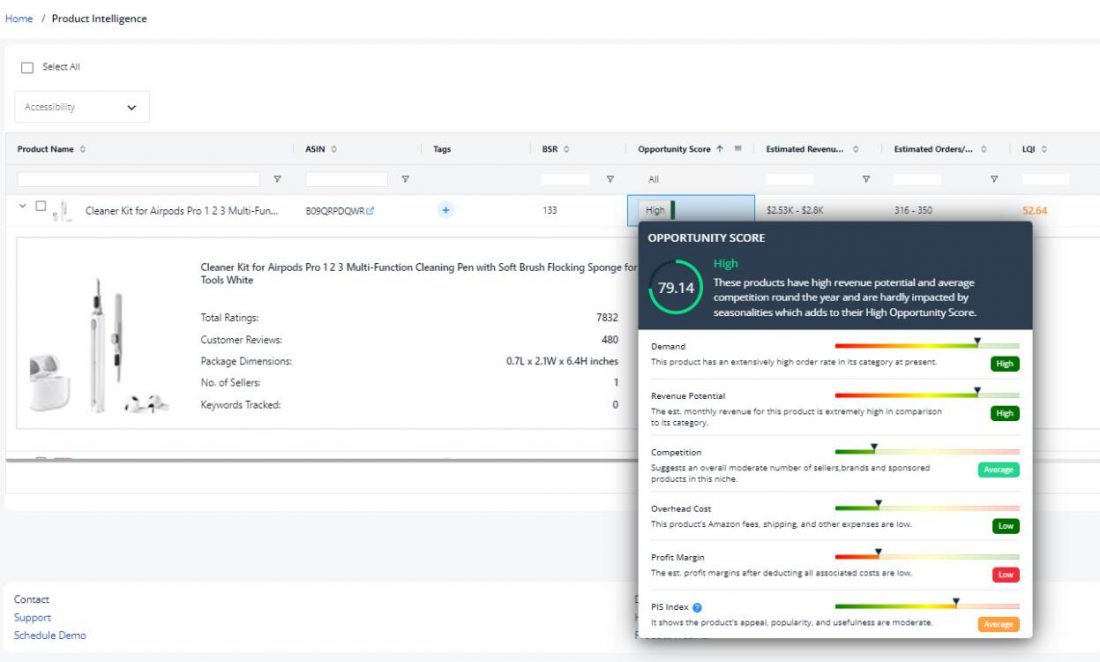
A high Opportunity Score indicates that the product can be highly profitable if you choose to sell, and vice versa.
The product has keywords with good search volume
Another effective method to gauge the product demand is to understand the various keywords, search volume, and search frequency for those keywords. If the product keywords already attract substantial search traffic, there’s no need to reinvent the wheel.
As a rule of thumb, see if the top 2-3 product keywords have at least a cumulative search volume of 10,000+ to effectively understand the demand for said product. Of course, this may vary based on your product type and niche.
Note: Stay away from a product with a very high search volume, as this niche might be too competitive to capture a portion of the market share and make a decent profit.
We recommend you use the SellerApp Reverse ASIN tool to find all top-performing keywords and search volume for the product.
Log in to the SellerApp dashboard. Go to the , and add your competitor ASINs. Here you can analyze the keywords based on search volume.
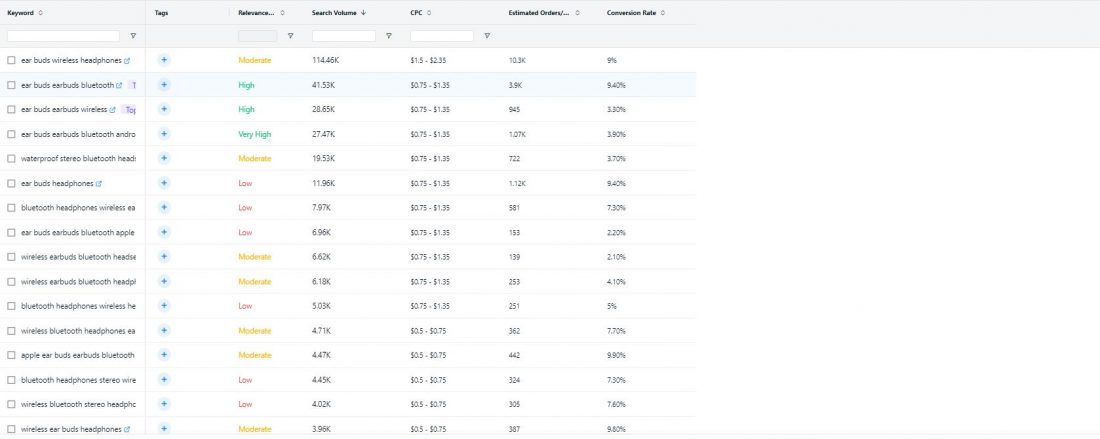
A product that promotes repeat purchases.
Selling a product that encourages repeat purchases like cosmetics paper products or packaging materials is a great way to improve customer lifetime value and your profits.
Additionally, selling these types of products can also help you build a brand and even customer loyalty.
Recurring purchases also indicate customer satisfaction and trust. They are also less likely to switch to competitors or substitutes. Most importantly, choosing to sell such a product also results in lower acquisition and marketing costs as you don’t have to spend so much money attracting new customers, as you already have a loyal customer base.
An evergreen product
Unfortunately, you need to consider seasonality as a factor when choosing to sell your product. As you can imagine, the product’s demand can fluctuate depending on the type. For example, demand for snow gloves drastically increases during winter and is non-existent in the summer season.
Some product demands also increase during specific holidays. For example, Halloween costumes or decorations.
Therefore, we recommend you get a general idea of the seasonality of the product using Google Trends. Specifically, to identify if the keyword search volume data of the product is steady across the year.
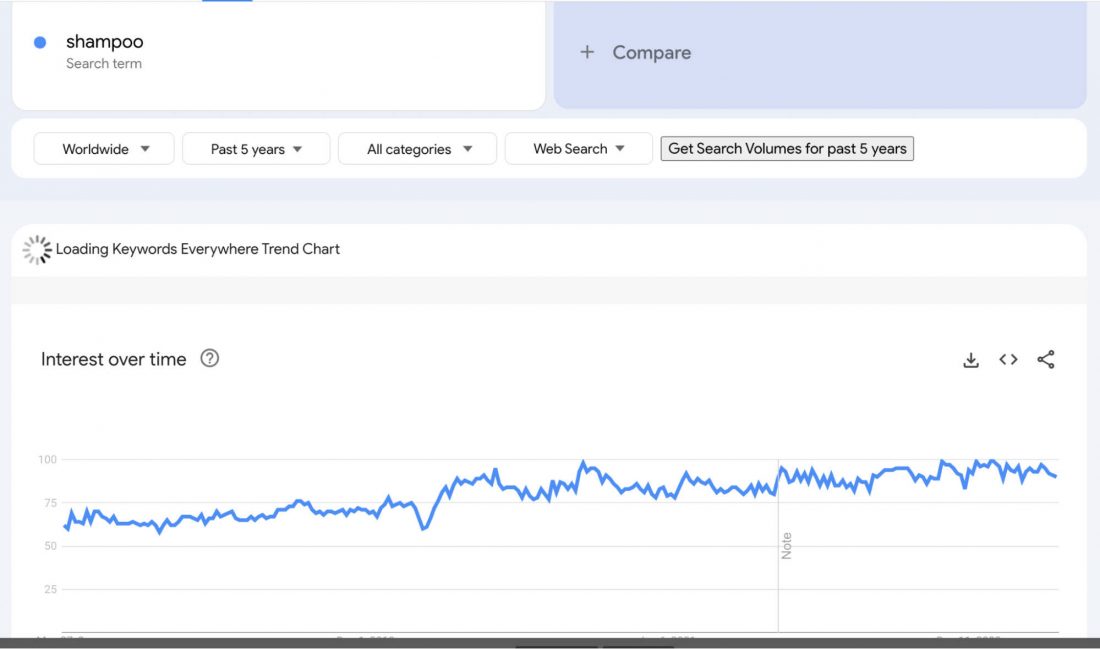
But if there’s a periodic spike in the search volume, it shows seasonality.
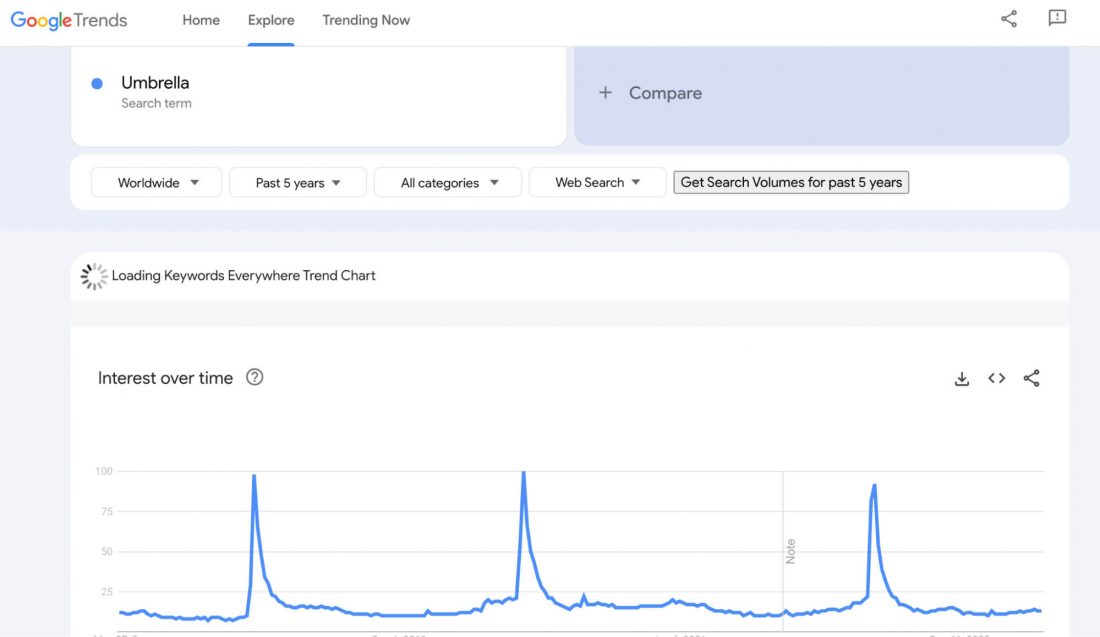
A business built around seasonal products may be profitable for a day or a season but wouldn’t be sustainable in the long run.
Review customer feedback
However, we recommend digging far deeper into the reviews than simply glossing over 3-5 reviews.
One of the best ways to track demand and understand the effectiveness of a product is to head to the customer review section and read the feedback.
Use the SellerApp Chrome Extension and gather all the reviews on Amazon for a specific product. You can filter by verified purchases to gather insights from the actual buyers and filter the reviews by star rating, text/video/image reviews, and even geography.
More importantly, use the Product Scanner Feature to gather the average ratings and reviews for all the products at the category or subcategory level to understand the overall demand.
Monitor pricing and track competitor inventory levels
Another way to understand product demand is to track competitor pricing and inventory levels. But by understanding the price wars between your competitors to win the buy box or even the fluctuations in selling price, you can understand the demand for the product to a certain level.
Although not amazingly insightful, you could still understand a certain level of demand by tracking your competitor’s inventory level and understanding how often they’re low in stock. Of course, this can take a significant amount of time, which is why it should ideally be an ancillary method to gauge demand.
Customer
In addition to Demand, you must deep dive into the niche and understand customer sentiment to understand your product has potential.
Look for Products with a low review count (About 2-3 Products With < 50 Reviews on Page 1)
Studying reviews is a necessary part of product research.
With this research, you can understand whether the product is effectively solving the customer’s pain point but it will also help you understand gaps in the competitive landscape that you can take advantage of.
For example, if you keep reading that Product X would be more easier to use with Feature Y. You could implement Feature Y into your product and sell it to capture market share from your customer.
Of course, reviews also help in more a straightforward manner. By reading the reviews you can understand if there is demand for the product. The number of sellers and the number of reviews split across them also give you insight into the difficulty of entering the market.
A good rule of thumb is to make a list of the top ten keywords for the product and check the top 10 products for each of those keywords. The product is likely to sell successfully if the top 10 products have less than 100 reviews.
However, if there are more than 1000 reviews, it’s best to move on to another product. When it comes to choosing the keyword go from broad to phrase and then to exact.
Identify the Unique Selling Proposition (USP)
Analyzing the product reviews and Q&A section can give you insight into not just the weaknesses and gaps with the product but also help you understand the strengths and unique selling points of the product.
Usually, if the top products already have 4.5+ ratings, there’s a high chance that these products are already “perfected”, and it will be difficult to identify gaps in the product.
But for products with less than 4.5 ratings, you can identify some negative reviews and understand the gaps in the products. Use these gaps to improve your products and tailor your product messaging.
Of course, this isn’t an absolute. You could always try to find opportunities to improve a nearly “perfect product” and launch a new one with additional features or improvements.
Competition
Other than Demand and Customer Insights, you must also thoroughly understand the competition. After all, there is no point in spending time and resources on launching a problem, only to be drowned by the competition.
Here are some key factors to consider when it comes to understanding the competition:
The barrier to entry should not be low
Don’t select a product that has a low entry barrier.
As obvious as it may sound, it’s important to understand that everyone can see the potential in this product and you will run into several new competitors, negatively impacting your business.
On the other hand, the more difficult to enter a new market, the fewer new sellers will pose a threat to your product. Therefore, look for products that require a relatively high capital investment, unique features, or strong differentiations from other products.
These types of products can help you avoid direct competition and create a niche market for yourself.
No Big Brands in the product category
Entering a product category dominated by big brands will always put you at a clear disadvantage. Here’s why:
- One, you will need to compete against their large marketing budgets and brand recognition. Capturing market share would be harder than going to the moon. Ok, maybe not. But the point still rests.
- Two, winning customers who are loyal to these brands can be significantly challenging. And if you try to work around their market share, you might be targeting a super narrow demographic, which would restrict your growth and profitability.
If you still want to compete against such dominant brands, ensure that you have a solid marketing strategy, a good product, a great brand story/mission/values, and exceptional customer service.
The Number of Sellers
Tracking the number of sellers should be a no-brainer – it can indicate the level of competition and the demand for that product. Generally, if there are too many sellers for a product, it would mean that the product is highly competitive, and you may have difficulty breaking into the market or succeeding once you’re in.
On the other hand, if fewer sellers exist in the category, it would mean less competition and more growth potential.
Profitability
Once you’ve evaluated a product’s demand, competition, and customers, you need to ensure that the product you sell is profitable.
Here are some factors to gauge the profitability of a product:
Look for Products Between the $20-$50 Price Range.
Products priced at $20-$50 lie in the impulse buying decision range. Fundamentally, the higher the price tag, the more a consumer thinks about spending the amount.
Meaning, that they’ll conduct more research and try to understand if they need the product, while with less expensive items, they won’t spend as much time comparing them to others.
Additionally, there is an extreme on the other end as well as shoppers may associate the product with cheap quality.
Sellers often tend to get into a black hole when trying to find the right pricing strategy for their products. Ultimately, while the impulse purchase range does have its benefits, it’s important to note that the product price should be set after calculating the expenses and profit. Most importantly, it should address the customer’s perceived value.
For example, a great example would be portable chargers like the famous BlendJet. The cost of manufacturing the product may be less than $10. However, with marketing and branding, you could build a perceived valuation of the product and potentially elevate the cost to $50-60.
Look for Lightweight Products
Yes, the size of the product is important. Especially, since there can be additional fees associated with shipping or storing the product. Therefore, it’s always advisable to look for small and lightweight products, as these types of products can keep your shipping and storage fees down, which usually are based on the weights and dimensions of the product.
For example, it would be much cheaper to source and sell a small product, such as a necklace, versus wooden furniture.
While wooden furniture may be in higher demand, the logistics cost will be humongous, which can eat up a massive chunk of your profit margin.
Key Tip: Don’t go for too light or heavy fragile products, like glass or electronics. Pick something sturdy and easy to ship.
Choose a Product With a Decent Profit Margin of 25-35%
The ultimate goal of your business should be profit.
Unfortunately, there are a ton of fees associated with selling on Amazon. So, it’s not a simple calculation of product cost and selling price. You will also need to factor in multiple factors such as subscription fees, selling fees, advertising fees, storage fees, shipping fees, etc.
Whenever you conduct product research, calculate the gross profit margin to specifically understand the earning potential of the product.
There is no particular profit margin to aim for, as it’s subjective. However, we recommend at least a 25-35% gross margin as this would help you build a successful business with long-term potential.
This will leave you with enough room for your advertising budget to stand out from the competition.
You can easily find the profit margin of a product by using the SellerApp FBA calculator.
Just go to the product listing on Amazon, open the SellerApp FBA Calculator tool, and provide the following information:
- Cost of Goods Sold
- FBA Fees
- Other Cost
And the tool will automatically calculate the profit margin for you.
Amazon Product Research Checklist
Here is a quick checklist to help you easily pick the right product to sell:
- Product prices should fall between the range of $10 and $50
- Products should make at least 10 sales a day
- The product should have a minimum best-seller rank of at least 5,000 in the main category
- The top 3 related keywords have 10,000+ monthly searches on Amazon
- Choose evergreen products instead of seasonal products
- The product must have at least 2-3 competitor products with less than 50 reviews on the first page of the Amazon SERPs
- Small and lightweight products (under 2 to 3 pounds)
- No brand names or trademarks associated with the product
- A product can be set up for 25% or even less than the sale price
- Proper room for product optimization and improvement of present listings. Take advantage of SellerApp’s Amazon Description Generator to help you create effective bullet points.
- There should be multiple product-related keyword opportunities
- The product should not be fragile
- There should be a potential to expand the brand with related products
- Can make a superior product over similar products in the market
- The product encourages repeat purchases
- The product should not have any legal or compliance issues
Techniques to Discover Good Product Ideas
Now that you’ve learned the four factors to consider when selecting a viable product, let’s look at some effective methods to discover the products.
Amazon Marketplace
Amazon is the first place you should research to identify good product ideas. Amazon has different categories like Bestseller lists, Movers and Shakers, Most Wished For, and Gift Ideas section, public wishlists all of which can offer countless product ideas to you.
First, visit Amazon’s Best Sellers page. Here, you’ll find the best-selling products for each category. Don’t stop your research in the top category. Go deep into subcategories to identify unique product ideas.
Additionally, you can also look at New Releases, Movers & Shakers, Most Wished For, and Gift Ideas tabs. These products will have high demand but less competition over the best-selling products.
Let’s say in the “New Releases” tab, you go for “Sports & Outdoors.” Now, this is way too broad a subcategory to identify product ideas. But you can go deep into subcategories to identify product ideas that you’ve never thought of.
For example, Sports & Outdoors > Exercise & Fitness > Cardio Training > Exercise Bikes.
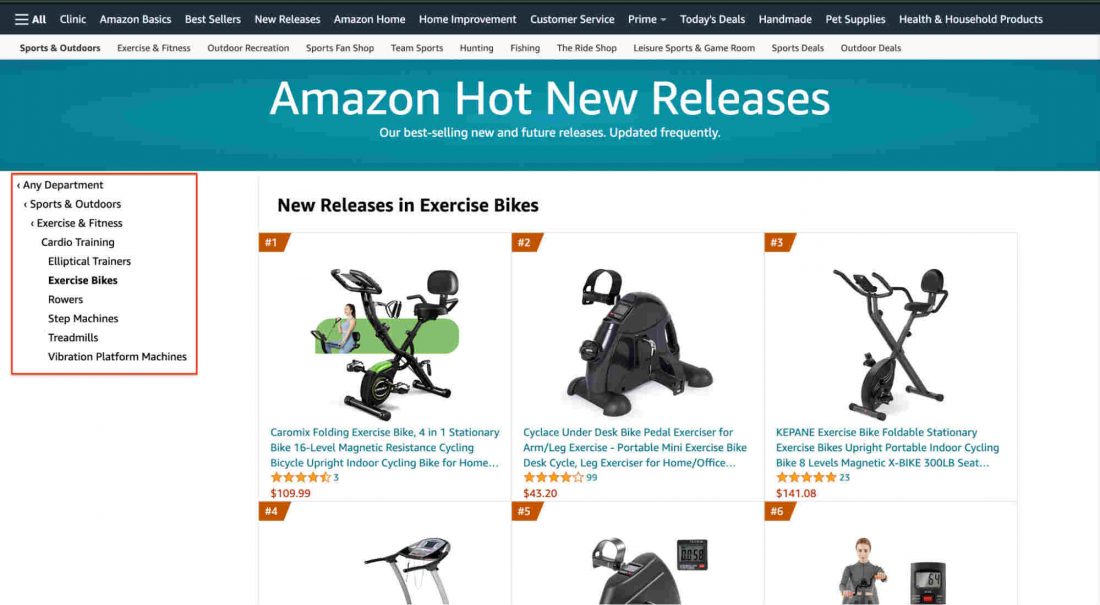
Under the “Exercise Bikes” subcategory, you can look through many product types.
Speak with Your Current Supplier
If you’re already an Amazon seller, the best and easiest way to do product research is by simply asking your suppliers what products are trending and selling like hotcakes now.
Your supplier should already have the information and might happily give it to you if you have a good relationship with them.
You can also make it worthwhile for the suppliers by giving them bulk orders for the new products.
Looking at eBay’s Trending List
Even if your target marketplace is Amazon, other marketplaces like Walmart, eBay, and AliExpress can still be valuable sources for identifying product ideas.
Usually, if one product sells well on other marketplaces, it’s more likely to sell well on Amazon too.
So, head over to other marketplaces like eBay or Walmart and view all the trending products in your favorite categories.
Not all products will fit your criteria, but you’ll get a rough idea of the product in demand and brainstorm from there to find a product that makes the perfect sense to you.
Visit Retail Stores
Visiting your local retail stores can also be a great way to discover new product ideas to sell on Amazon.
These local stores often sell unique products that are not available online. These shops also serve as a real-time platform for identifying current trends and conducting price comparisons, which can provide you an edge over the competition.
Additionally, physical retail stores allow you to do a detailed quality assessment and help you make more informed decisions about the products to sell.
Use Amazon Product Opportunity Explorer
If you’re already an Amazon seller, use the Amazon Product Opportunity Explorer tool on Seller Central to find new products.
Log in to your Seller Central account, and navigate to Growth → Product Opportunity Explorer.
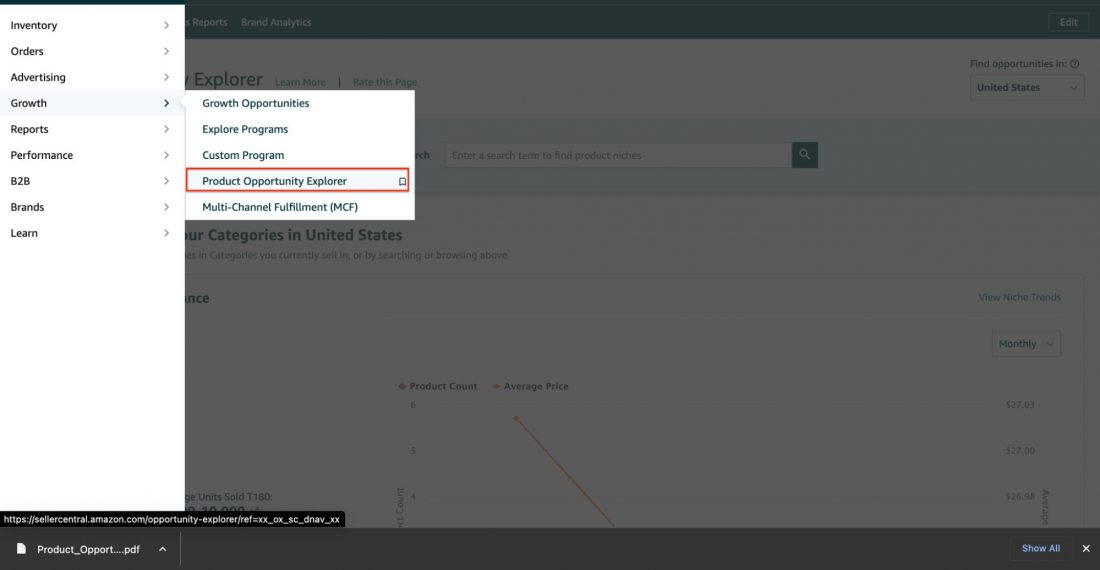
Use the search box to enter a broad keyword related to the product or niche you’re interested in.
Alternatively, you can browse niches by category or use the example niche recommendations based on your current product offerings.

The tool will display relevant niches, associated search terms, and key metrics such as customer needs, top search terms, search volume, units sold, average price, and price range.
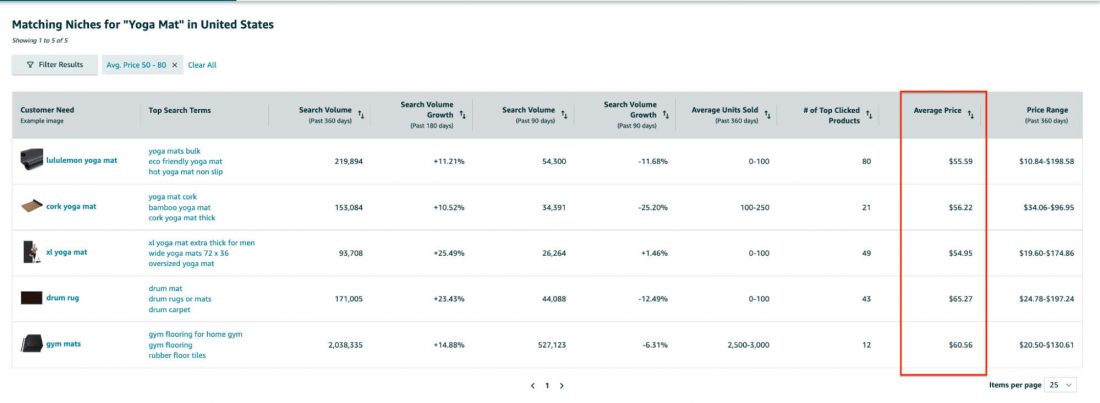
You can use these metrics to filter and narrow down your search to avoid low-quality products.

Not just that, utilize the Customer Review Insights section to identify improvement opportunities within a product and niche. It shows you all the positive and negative reviews for both niche and product levels.
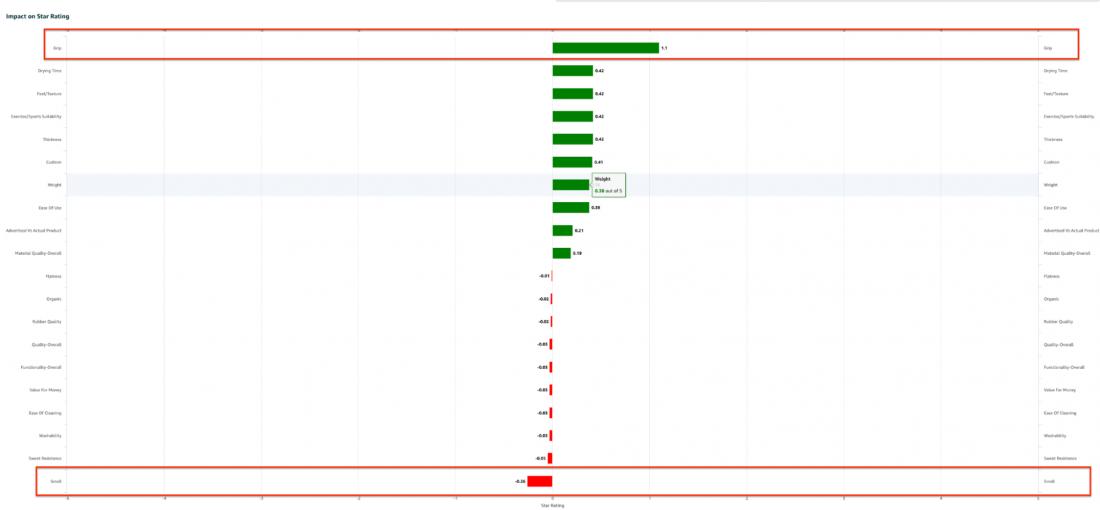
With this Product Opportunity Explorer tool, you can narrow down profitable product ideas backed by data and are less likely to fail.
SellerApp also offers a comprehensive Product Research tool that helps you research products on Amazon.
Just log in to the SellerApp Dashboard, go to the Product Research tool, and search with a seed keyword. The tool then gives you a list of products based on your search query.
You can filter the keywords based on multiple metrics to narrow your search to the most relevant products.
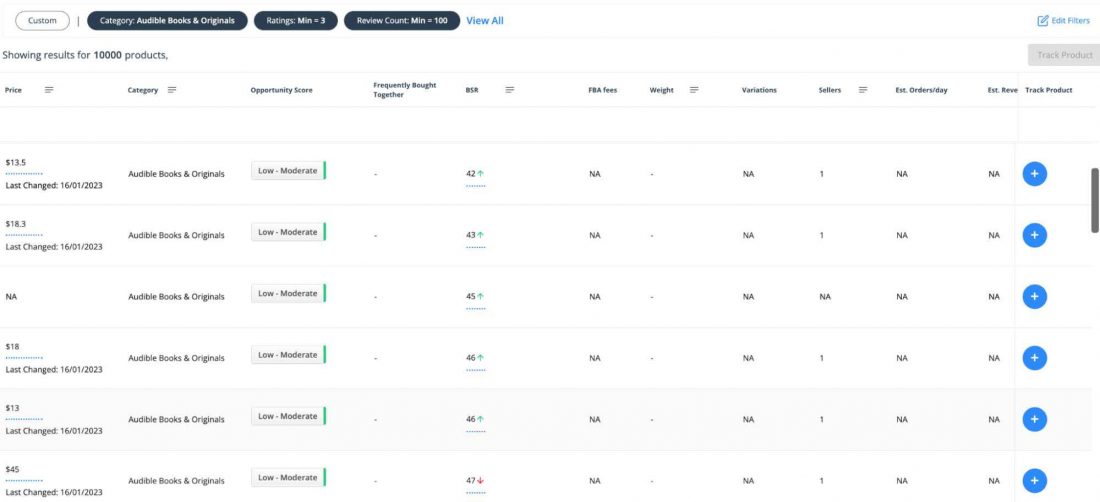
Final Thoughts
There you have it, a comprehensive checklist for Amazon Product Research!
As you can see, there are many aspects to consider to conduct thorough FBA product research, Following the steps given in this post will help you get started with your Amazon product analysis.
However, if you’re looking for an efficient way to accelerate progress, consider signing up on SellerApp Dashboard. It gives you free access to invaluable features such as product analysis and tracking to help you find the best-selling products for your next launch.
Leave a comment below and let us know what Amazon product research strategies you use in your business!


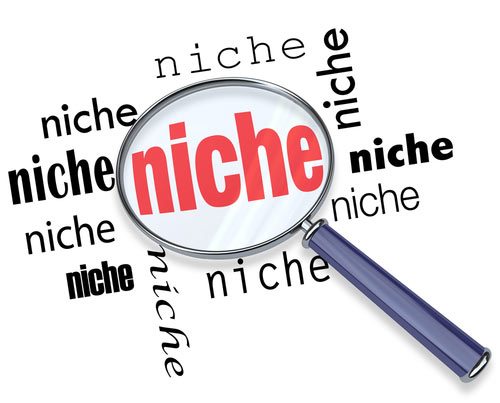
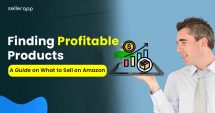





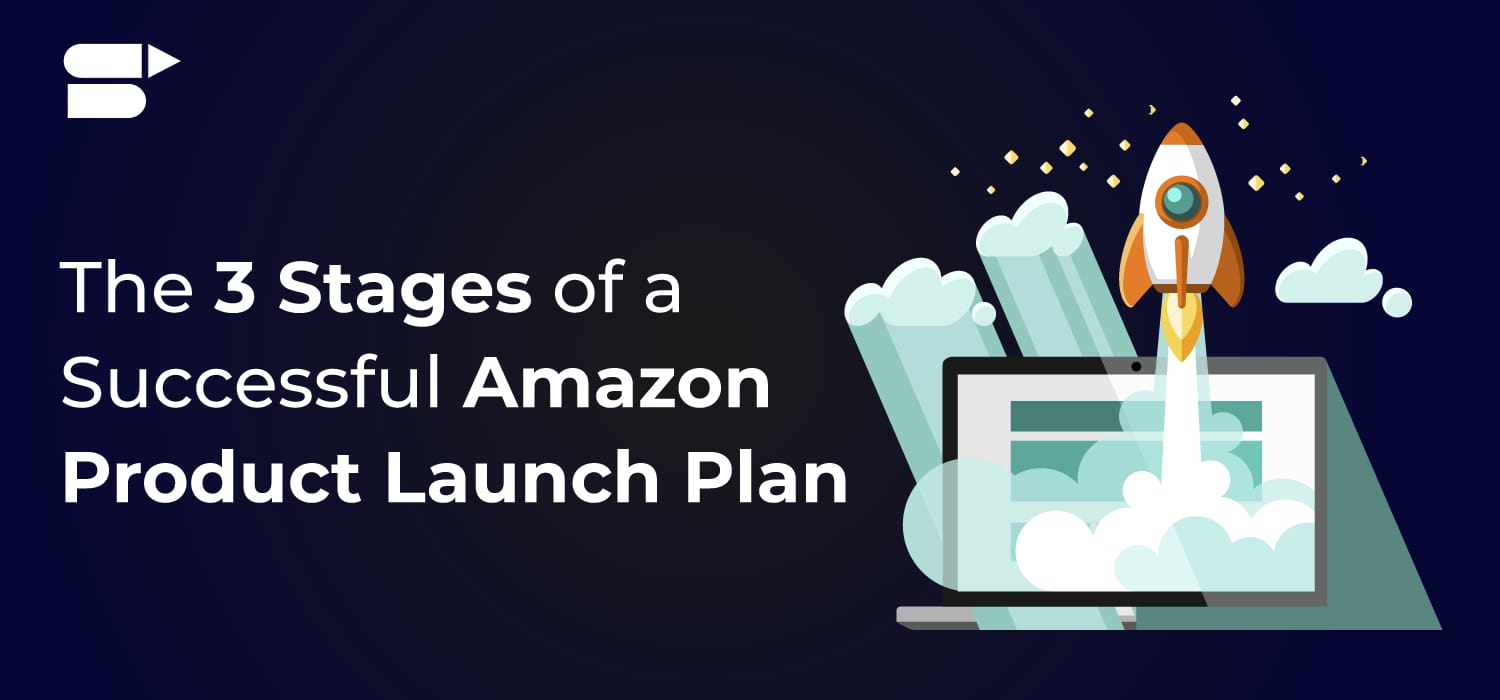
Dagonet
January 10, 2023SellerApp blogs are a wealth of knowledge for sellers. You cover everything from product research to marketing, and I’ve been able to improve my sales as a result.
Arishekar N
January 16, 2023Thank you.
Amado
January 11, 2023I’ve been able to improve my product research and sourcing thanks to the information provided in SellerApp blogs. They have really helped me find profitable products to sell.
Arishekar N
January 16, 2023Glad you liked.
Daniel Patrick
July 10, 2024The information provided is Really valuable.
Clare Thomas
August 14, 2024Thank you for your support.
Michael David
July 20, 2024Appreciate the details. This blog explained the methods for product research very well.
Clare Thomas
August 14, 2024Glad to hear this article is helpful.
Sophia Anne
July 21, 2024Fantastic tips! Helps a lot.
Clare Thomas
August 14, 2024Thank you!
Jack Robert
July 22, 2024Thanks for the useful information, Must read content for a amazon seller.
Clare Thomas
August 14, 2024Thank you for your valuable feedback.
Elizabeth Marie
July 23, 2024Good! Very clear explanation, I like this article.
Clare Thomas
August 14, 2024Glad you like it.